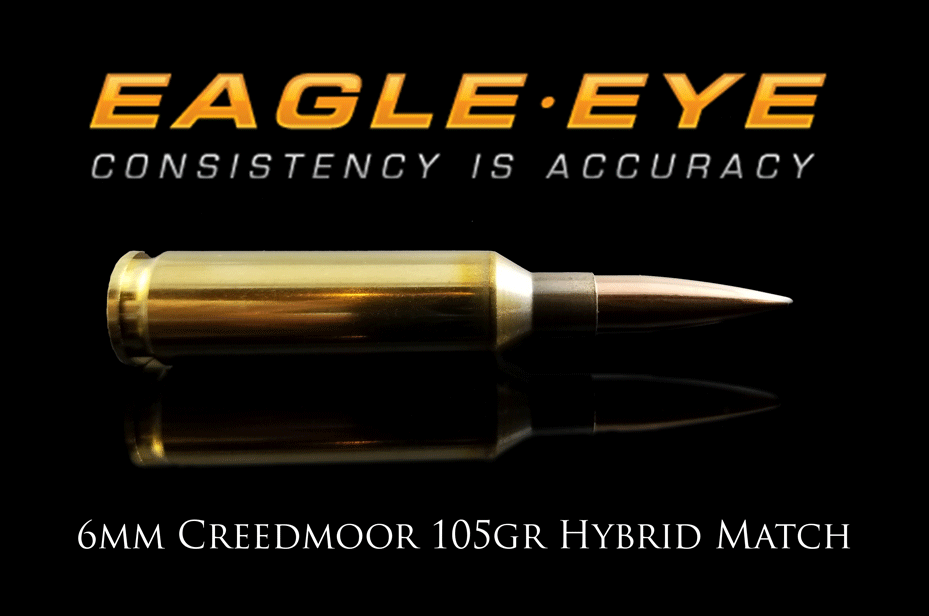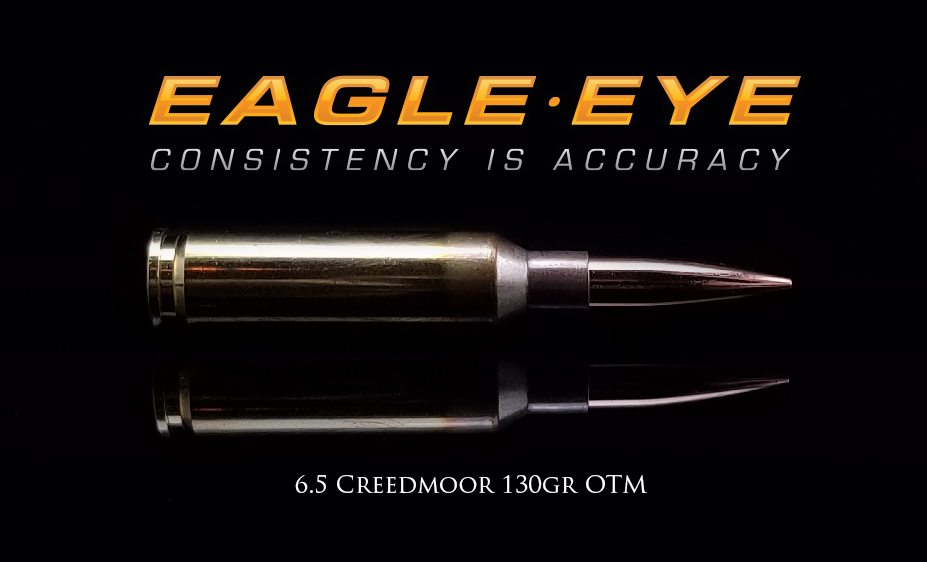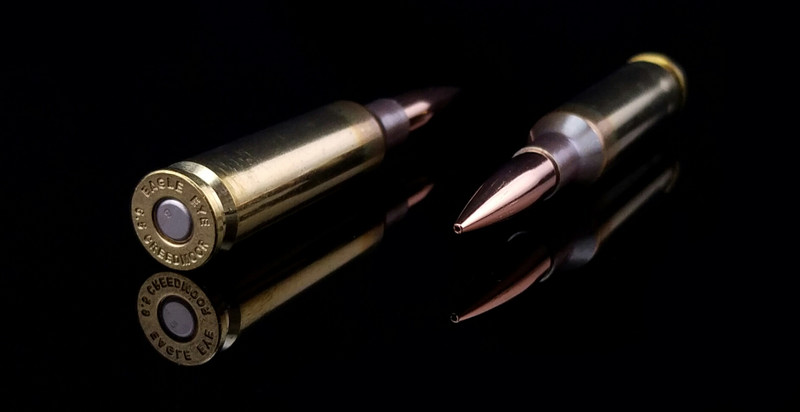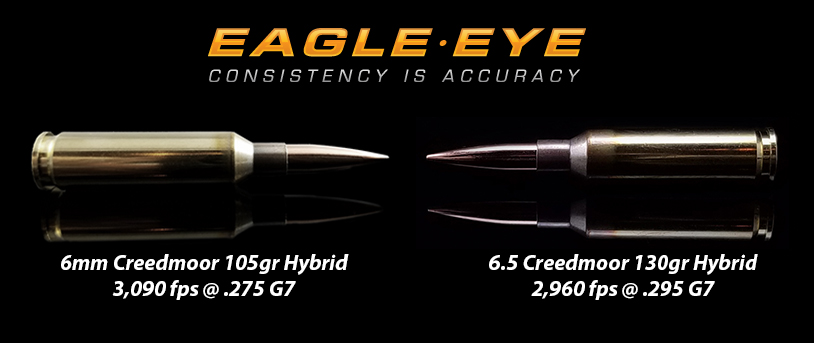6mm vs 6.5 Creedmoor - A Ballistic Comparison
Over the past decade the 6.5 Creedmoor has become among the most popular long range shooting cartridges available. Recently, the 6mm Creedmoor cartridge which propels lighter thinner 6mm/.243 caliber bullets at higher velocities is becoming an attractive alternative. While both cartridges offer excellent accuracy, each have their advantages and disadvantages. We compare our Eagle Eye Precision Match loadings of each cartridge to help shooters determine which is the best choice for their application.
At Eagle Eye, we engineer and manufacture the most accurate and consistent precision match ammunition optimized for long range precision shooting. With the addition of 6mm Creedmoor ammunition and brass cases to our product line, this blog provides a comparison between the our 6mm Creedmoor and 6.5 Creedmoor as well as other standard factory loadings. More information on our Precision Match Ammunition can be found here and information about our precision brass cases can be found here.
Overview:
As their names imply the biggest difference between the 6mm Creedmoor and the 6.5 Creedmoor is the bullet class. The 6.5 Creedmoor shoots 6.5mm/.264 class projectiles while the 6mm Creedmoor is necked down to shoot 6mm/.243. bullets. The Eagle Eye 6.5 Creedmoor shoots a 130gr hybrid projectile with a .295 G7 at 2,960fps from an average 26" barrel. Comparatively, the Eagle Eye 6mm Creedmoor shoots a 105gr hybrid projectile with a .275 G7 at 3,090fps from an average 26" barrel. While the lower mass of the 6mm bullet results in a higher velocity it also results in a lower ballistic coefficients than the heavier 6.5mm bullet. As we noted in a previous blog on Loading for Long Range Precision Shooting 1) each Eagle Eye Precision Match cartridge is loaded to its maximum potential without sacrificing accuracy to optimize long range precision and 2) there is a trade off between ballistic coefficient and velocity. The overall ballistic performance is dependent on the interaction of both ballistic coefficient and velocity. We compare the ballistic performance of each Eagle Eye cartridge and other generic factory loadings.
Accuracy:
Both the 6mm Creedmoor and 6.5 Creedmoor cartridges are capable of outstanding accuracy. With high quality loadings such as Eagle Eye Precision Match Ammunition and when fired from quality well maintained rifles, both calibers are easily capable of sub 1/2 minute accuracy. The limiting factor in accuracy with both cartridges will be atmospherics (ie. wind) and shooter skill. The picture below shows 5-shot groups from Eagle Eye 6mm and 6.5 Creedmoor loadings.

Eagle Eye 6mm Creedmoor and 6.5 Creedmoor 5-Shot Groups Accuracy Test
Ballistic Tables:
6mm vs 6.5 Creedmoor Ballistic Trajectory Comparison
(Drop / Path & Drift Mil’s / Inches)
|
Distance (Yards)
Drop / Path (mil/in) Drift (mil/in) |
Eagle Eye 6.5 Creedmoor 130gr (.295 G7 @2960fps) |
Factory 6.5 Creedmoor 140gr
(.315 G7 @2750fps) |
Factory 6mm Creedmoor 108gr
(.270 G7 @ 3000fps) |
Eagle Eye 6mm Creedmoor 105gr (.275 G7 @3090fps) |
| 200 Yards |
+0.2 mil / -1.8 in
+0.3 mil / -1.83 in |
+0.3 mil / -2.5
+0.3 mil / -1.9 |
+0.2 mil / -1.7 in
+0.3 mil / -1.99 in |
+0.1 mil / -0.6 in
+0.3 mil / -1.88 in |
| 400 Yards |
+1.4 mil / -20.6 in
+0.6 mil / -7.48 in |
+1.7 mil / -24.9
+0.5 mil / -7.75 |
+1.4 mil / -20.3 in
+0.6 mil / -8.26 |
+1.2 mil / -16.9 in
+0.6 mil / -7.77 in |
| 600 Yards |
+3.0 mil / -63.9 in
+0.8 mil / -17.63 in |
+3.5 mil / -75.3
+0.8 mil / -18.18 |
+3.0 mil / -63.9 in
+0.9 mil / -19.59 in |
+2.6 mil / -56.5 in
+0.8 mil / -18.40 in |
| 800 Yards |
+4.8 mil / -138.1 in
+1.1 mil / -33.04 in |
+5.6 mil / -160.7
+1.2 mil / -33.99 |
+4.8 mil / -139.5 in
+ 1.3 mil / -36.94 in |
+4.4 mil / -126.1 in
+1.2 mil / -34.67 in |
| 1,000 Yards |
+7.0 mil / -251.8 in
+1.6 mil / -57.20 in |
+8.1 mil / -290.4
+1.6 mil / -56.15 |
+7.2 mil / -257.6 in
+1.7 mil / -61.67 in |
+6.5 mil / -234.8 in
+1.6 mil / -57.70 in |
1,500ft Elevation 30.0 Barometric Pressure, 30% humidity, 59.5 deg F, 10mph 90 deg crosswind
Trajectory - Drop:
When comparing the trajectory of the two cartridges, the 6mm Creedmoor is the clear winner. The considerably faster velocity of the 6mm Creedmoor means that the amount of time gravity is influencing the flight path is less. The flatter trajectory of the 6mm Creedmoor can be seen immediately and grows considerably with distance. At 1,000 yards the Eagle Eye 6mm is approximately .5 mil or 17" flatter than the Eagle Eye 6.5. For shooters engaging targets at unknown distances the flatter trajectory provides an additional cushion for errors in range estimation. When engaging multiple targets at varying distances, the flatter trajectory makes for faster adjustments or smaller holdover corrections. The video below shows the extremely flat trajectory of the Eagle Eye 6mm Creedmoor 105gr Hybrid ammunition at 980 yards. With the higher elevation of 3,600 feet above sea level only 5.5 mils of elevation was needed to reach the target. Watch for the bullet trace.
Eagle Eye 6mm Creedmoor 105gr Hybrid Ammunition with Eagle Eye Precision Rifle using Mausingfield Action, Shilen Barrel in glass bedded Grayboe Stock, 3,600 ft, 26.2 Barometric Pressure, 80 Degrees F, 30% Humidity, 3,140 fps Muzzle Velocity 5.5 mil's elevation
Subsonic Transition:
For extreme long range shooting, both the Eagle Eye 6mm and 6.5 Creedmoor maintain supersonic flight for significant distances. Both cartridges will being to enter subsonic velocities at approximately 1,450-1,5000 yards depending on atmospherics. The extended range to which both cartridges remain supersonic contributes to enhanced bullet stability and increased hit probability at longer distances past 1,000 yards.

| Shop Eagle Eye 6mm Creedmoor 105gr Hybrid Ammunition Here |
Wind Drift:
The higher velocity of the 6mm bullet means that the amount of time wind will be imparting a force on it is less. However, because of the heavier mass and higher ballistic coefficient of the 6.5mm bullet, the amount of force needed move the projectile is higher. In the case of the Eagle Eye loadings, the two are nearly identical with only 0.5" difference at 1,000 yards. Some heavier higher BC 140gr class 6.5mm projectiles will experience slightly less drift on the order of approximately 1.5" at 1,000 yards in other generic factory loading specifications. Although 1.5" is a technical difference, the question is whether or not it is of practical significance in real world shooting conditions. Conversely, standard 6mm Creedmoor loadings with lower velocities have significantly more wind drift.
In the case of a competition shooter who is shooing strings at known distances from a constant stable shooting position with standardized wind flags to aid in wind speed estimation and ultra fine scope turret adjustments (1/8 minute or less), it could be argued that in this context, that any difference is significant.
In contrast, a shooter engaged in more of a precision rifle (PRS) or tactical type shooting scenario where there are not standardized wind flags, the shooter is shooting from alternative firing positions and distances are unknown the technical difference may be of less practical significance. First, many tactical type rifle scopes today are built with .1 mil (or alternatively 1/4 moa) elevation and wind adjustment turrets. The 1.5" difference between a heavier 140gr 6.5 Creedmoor and the Eagle Eye 6mm Creedmoor is approximately 0.04 mil or .14 minutes. The magnitude of the difference is less than the value of one unit of adjustment or one click (.1 mil or 1/4 minute) on many scopes. This difference is almost too small to correct for. Secondly, a 1mph error in wind speed estimation results in over 6" difference in drift at 1,000 yards or approximately approximately 4 times the difference in drift between a higher bc 140gr 6.5 and the Eagle Eye 6mm. Considering winds are not constant and there can be multiple wind vectors between the shooter and the target, estimating wind to less than 1/2 mph accuracy is exceedingly; difficult even with wind meters or standardized competition wind flags present. Wind estimation will likely account for more variation in drift than the difference between the two cartridges. When compared to all sources of variation wind drift cumulatively that the difference may be seen to be of lower practical significance.

| Shop Eagle Eye 6.5 Creedmoor 130gr Hybrid Ammunition Here |
Recoil:
Both the 6mm Creedmoor and 6.5 Creedmoor are light recoiling cartridge that are easy to shoot; especially for extended periods of time. That said, the 6mm Creedmoor does have noticeably less recoil. In the absence of a muzzle brake, one advantage of the lower recoil is that for some it can be easier to spot trace and return to target quicker. These advantages can be accentuated if the shooter is using a lightweight rifle and/or shooting from unconventional firing positions.Returning to the topic of wind drift, when there is an error in wind estimation, since winds are constantly shifting, one of the best things to do is to get a second follow up shot off quickly before the winds change. The lighter recoil may assist some shooters in spotting trace and getting an adjusted second on target shot off slightly quicker. Again, modern muzzle brakes have become very efficient and when either cartridge is paired with one, the magnitude of the difference becomes smaller.
Kinetic Energy:
One place where the 6.5 Creedmoor has a clear advantage over the 6mm Creedmoor is with respect to kinetic energy. While terminal ballistic performance depends heavily on shot placement and projectile design, putting more energy on target is always beneficial. Kinetic Energy = 1/2Mass*Velocity^2. Since velocity is squared, increased speed can often lead to substantial gains in kinetic energy. However, as with everything in ballistics there is a tradeoff. While the 6mm Creedmoor is significantly faster than the 6.5 Creedmoor, the velocity of the 6mm is not enough to make up for the extra mass of the heavier 6.5 Creedmoor projectiles. The additional mass of the 6.5 bullets allow them to retain more kinetic energy at distance. The kinetic energy advantage of the 6.5 Creedmoor grows to a nearly 20% advantage at 1,000 yards with the 6.5 retaining 750 ft/lbs while the 6mm retains only 627 ft/lbs.
Hunting:
Both the 6mm Creedmoor and the 6.5 Creedmoor make excellent hunting cartridges. We load our Eagle Eye Precision Hunting Ammunition to the exact same standards and tolerances as our precision match ammunition. Premier projectiles such as Berger Classic Hunter bullets are used in our hunting cartridges. Similar to the kinetic energy with match bullets, the Eagle Eye 6.5 Creedmoor Berger 135gr Classic Hunter offers more kinetic energy while the Eagle Eye 6mm Creedmoor Berger 95gr Classic Hunter offers a flatter trajectory. However, beyond 500 yards the 6.5 begins to take the edge in retained energy. The Eagle Eye 6mm Creedmoor 95gr Berger Classic Hunter offers 2,297 ft/lbs of muzzle energy and 472 ft/lbs at 1,000 yards while the Eagle Eye 6.5 Creedmoor Berger 135gr Berger Classic Hunter offers 2,520.9 ft/lbs of muzzle energy and 771.5 ft/lbs at 1,000 yards. At 500 yards the 6.5 Creedmoor drops 2.1 mil with .6 mil drift in a 10mph crosswind compared to 1.7 mil of drop and .7 mil of drift for the 6mm Creedmoor. At 1,000 yards the difference becomes considerably more pronounced with the 6.5 Creedmoor dropping 7.2 mil compared to only 6.5 mils for the 6mm Creedmoor. However, trajectory drop is only half the story. While the two cartridges have similar wind drift out to approximately 500 yards, for a 10mph crosswind, the 6.5 Creedmoor only has 1.5 mil of drift at 1,000 yards compared to 1.9 mil for the 6mm Creedmoor. The high initial velocities of both of the Eagle Eye Hunting cartridges allow them to both stay well supersonic past 1,000 yards ensuring enough velocity and energy to effectively expand even at long ranges. Compared to many other traditional factory match or hunting loadings, the Eagle Eye Precision Match Hunting Ammunition offers flatter trajectories, less drift and more energy in target. Combined with exceptional accuracy and low velocity standard deviations, both calibers of Eagle Eye Precision Match Hunting Ammunition provide match grade sniper accuracy, consistency and reliability to ensure when the perfect shot presents itself nothing is left to chance.
Twist Rate and Bullet Stability:
In order to obtain peak performance it is essential that the bullet be fully stabilized in flight. The stability of the bullet depends primarily on how fast it is spinning. The imparted RPM's of a bullet is a function of the velocity and the barrel twist rate. The higher the velocity and the faster the twist the higher the RPM's. Generally, the twist rate is of more importance than the velocity as a small change in twist can have much larger effects on stability whereas it generally takes rather significant changes in velocity to have an effect on stability. Velocity would be more of a concern between calibers than within calibers. For example, a 223 rem will not have the case capacity to accelerate heavy 90gr+ bullets to stability where as a 22-250 Ackley improved may be able to get away with a slower twist rate by virtue of significantly higher velocities. In practical terms it is very difficult to over stabilize a bullet and over stabilization is almost never a concern.
In the 6.5 Creedmoor virtually all mainstream rifles utilize a 1-8 twist rate and virtually all mainstream bullets will be fully stable in a 1-8 twist barrel; even in short barrels producing lower velocities. In practical terms, worrying about twist rate and stability is not a major issue in the 6.5 Creedmoor.
Conversely, twist rate and stability is a critically important factor to consider in the 6mm Creedmoor. 6mm Creedmoor barrels tend to be chambered between 1-7 and 1-8 twist. The 105gr Hybrid we use in our Eagle Eye Precision match loading is fully stable in slower 1-8 twist barrels and in short barrels with lower velocities. The stability of the 105gr hybrid is one reason we choose to use it in our loadings. Some of the heavier 110 require a full 1-7 twist to fully stabilize. When a bullet is unstable or marginally stable a few things can happen. In the worst case, the flight path will be erratic and it will be impossible to shoot accurately or obtain good groupings. However, a more nuanced problem with marginally stable bullets. In the case of marginally stabilized bullets they may group well but they will 'wobble' in flight or more technically exhibit yaw, pitch and percession in flight (think of it like throwing a football without a perfect spiral). The effect of this type of flight profile is increased drag and an effective reduction in the observed ballistic coefficient.
Barrel Life & Cleaning:
One place where the 6.5 Creedmoor is a clear winner is barrel life. 6mm calibers, including the 6mm Creedmoor tend to have shorter barrel life than other calibers. In our Eagle Eye 6mm Creedmoor 105gr Hybrid loading we use a slower cooler burning propellant blend than common industry standards such as H4350. The use of a slower cooler burning propellant helps to slow throat erosion and extend barrel life.
Some users have reported that the the 6mm Creedmoor tends to exhibit carbon buildup more rapidly. In our experience, the excess buildup of carbon tends to be the product of poor cleaning or lack of cleaning which allows carbon deposits to harden. With regular cleaning between range days, the carbon buildup can be easily kept in check. We recommend Bore Tech cleaning products and their C4 Carbon Remover for situations in which excessive and hardened carbon build-up becomes present in a barrel.
The Eagle Eye Advantage:
While other factory ammunition is commonly downloaded, Eagle Eye Precision Match Ammunition is loaded to its maximum potential and optimized for long range precision. The full magnitude of the difference can be seen in the table above. The result of the higher performance of our 6.5 Creedmoor contrasted with the generic loading specifications of standard factory ammunition means that our 6.5 Creedmoor provides a trajectory on par with, if not better than some other 6mm Creedmoor loadings. Since 6mm bullets are lighter and have lower ballistic coefficients, the failure to maximize the velocity potential of the 6mm Creedmoor by other factory loadings results in a significant increase in wind drift. In the case of other factory loadings, choosing between a 6mm Creedmoor and a 6.5 Creedmoor forces the shooter to chose between a flatter trajectory of the 6mm or the reduced wind drift of the 6.5. The better loading optimization of the Eagle Eye 6mm Creedmoor requires no such compromise. With the Eagle Eye 6mm Creedmoor the shooter gets a significantly flatter trajectory with a practically identical wind drift.
Eagle Eye 6.5 Creedmoor 130gr Hybrid Velocity Test
Conclusion:
The 6mm Creedmoor is rapidly gaining in popularity and for good reason. The 6mm Creedmoor provides clear advantage over the 6.5 Creedmoor with respect to the flatness of the trajectory while offering a similarly minimal wind drift; especially when compared to other cartridges such as a 308 Winchester. However, the ballistic advantages of the 6mm Creedmoor come at the cost of some barrel life and the 6mm Creedmoor does not offer the same levels of kinetic energy as the 6.5 Creedmoor. Nonetheless, 6mm Creedmoor is a fantastic, accurate and fun cartridge to shoot that deserves serious consideration.



